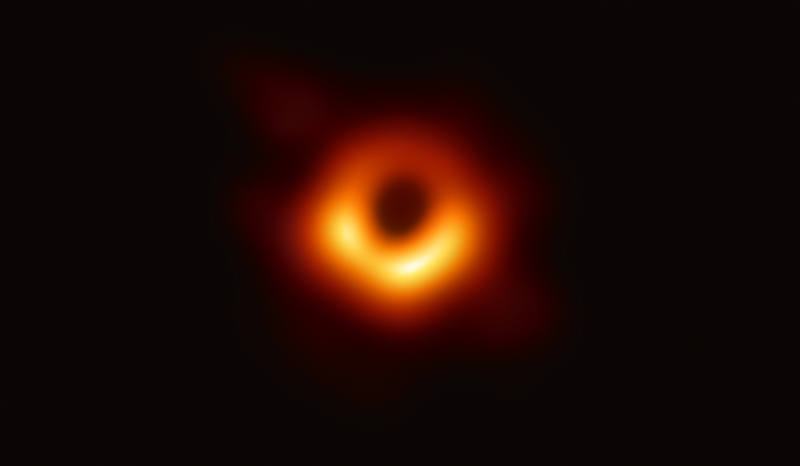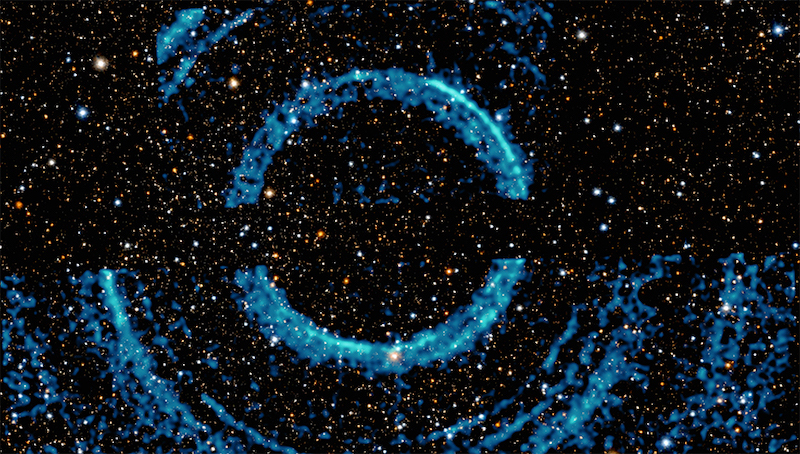A black hole with rings
You’ve probably seen the incredible first real image of a black hole, released in 2019. Here’s another spectacular image: a black hole with rings. The Chandra X-ray Observatory released this new image earlier this month (August 5, 2021). It’s a composite that shows the ring-encircled black hole in X-rays, infrared and visible light. Light echoes, similar to sound echoes on Earth, are thought to create these rings.
Astronomers identified a total of eight concentric rings for the black hole V404 Cygni in 2015. This black hole, V404 Cygni, is in a binary system 7,800 light-years away. The companion star in the binary system is about half the mass of our sun. Astronomers first saw V404 Cygni’s rings in X-ray images. The rings can’t been seen in visible light. NASA’s Chandra X-ray Observatory and the Neil Gehrels Swift Observatory (Swift) acquired the data to reveal the rings and create the new image (top of post) in 2015.
What created the rings?
The rings are created by light echoes, a phenomenon that is similar to echoes on Earth produced by sound waves bouncing off hard surfaces. So the rings are, in effect, echoes that can’t be heard or seen in ordinary visible light. The X-rays from the black hole bounce or “echo” off interstellar dust clouds between the black hole and Earth. It should be noted that these are dust clouds completely separate from the black hole, and not the accretion disk of dust around the black hole itself. From the press release:
Instead of sound waves bouncing off a canyon wall, the light echoes around V404 Cygni were produced when a burst of X-rays from the black hole system bounced off of dust clouds between V404 Cygni and Earth.
Who discovered the rings?
Initially, the Swift telescope detected a burst of X-rays coming from V404 Cygni, on June 5, 2015. The researchers, led by Sebastian Heinz of the University of Wisconsin-Madison, analyzed 50 observations of the system made by Swift in 2015 between June 30 and August 25. In addition, they also looked at Chandra observations from July 11 and 25, 2015.
The X-ray burst from V404 Cygni was bright, so bright that the team decided to situate it in-between the detectors of the telescope so as to avoid damaging it.

As you can see in the images, the rings are very prominent in the X-ray wavelength. However, you wouldn’t see anything if you looked with just your eyes. This is a great example of how there is a lot of structure and activity in the universe that human eyes can’t see at all.
More science results
The images are not only cool to look at, they also provide scientists with information about the black hole, the companion star and the dust clouds. Also, astronomers can calculate the distance to the dust clouds by examining the diameter of the rings. The larger the rings, the closer the dust clouds are to Earth.
By looking at the spectra of the X-rays, astronomers can also determine the composition of the dust in the dust clouds. Their results indicate that the dust grains are most likely composed of graphite and silicate. One key finding was that the densities of the dust clouds don’t seem to be uniform in all directions. That result came from analyzing the inner rings with the Chandra telescope.

Similar rings were also previously detected around Circinus X-1, a neutron star (and also a binary system) 30,700 light-years away. A neutron star is the remaining collapsed dense core of a massive star that has exploded.

Bottom line: Huge rings, like “light echoes”, were discovered around the black hole V404 Cygni. The rings are only visible in X-ray images.
Source: A Joint Chandra And Swift View of the 2015 X-Ray Dust-Scattering Echo of V404 Cygni (preprint)











